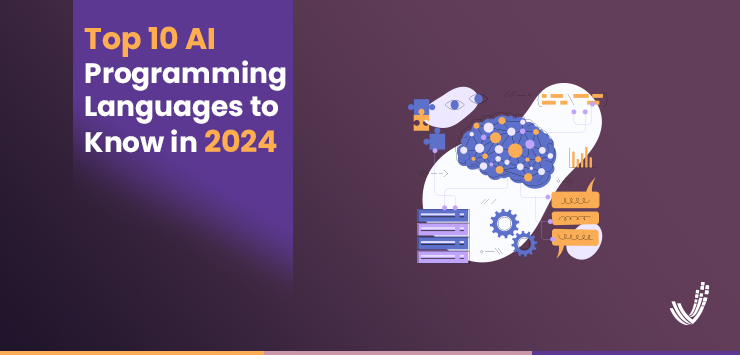AI programming languages are kind of like special codes that let computers act smart (but they are more complex than that). These languages are what make all the cool AI features we see today possible, from figuring out what you might want to buy online to helping factories run smoothly.
As technology keeps getting more advanced, especially in areas like artificial intelligence and machine learning, the need for people who can speak these special AI languages is growing fast.
New frameworks, libraries, and tools are being launched all the time, and staying on top of them is important for both developers and businesses in 2024.
For developers, learning these opens doors to exciting jobs and keeps them competitive. Retail Businesses can use the latest AI languages to access the newest technologies and stay ahead of the curve in their industry.
It also lets them unlock the full power of AI to create new ideas, work more efficiently, and give their customers the best possible products and services.
Today, we’ll explore the 10 best AI programming languages to give you a better idea of which one you might choose for your next project—and more.
Top 10 AI Programming Languages to Know in 2024
1. Python

Its syntax and rich ecosystem make it ideal for prototyping, experimenting, and deploying sophisticated AI solutions. It is used for various applications and offers comprehensive toolkits to effectively tackle a wide range of challenges that come along with machine learning algorithms, natural language processing, and real-world AI implementation.
2. JavaScript

TensorFlow.js allows developers to build and train machine learning models directly in the browser or Node.js environments. With its seamless integration with JavaScript, developers can create interactive AI applications, including image and speech recognition, without the need for additional frameworks. This enables the democratization of AI, making it accessible to a broader audience of web developers.
3. Java

With its focus on performance and efficiency, Deeplearning is well-suited for large-scale AI applications in industries like finance, healthcare, and e-commerce. Java developers can utilize Deeplearning4j’s comprehensive toolkit to build and deploy AI solutions that tackle complex data processing tasks and predictive modeling.
4. C++

C++ developers leverage Caffe’s flexible architecture and pre-trained models to develop advanced AI algorithms for tasks such as object detection, facial recognition, and autonomous vehicles. Caffe’s extensive library of models and tools streamlines the development process, enabling C++ developers to create cutting-edge AI applications with ease.
5. R

R’s focus on data manipulation and visualization makes it particularly suitable for tasks like predictive analytics, machine learning, and data mining. The intuitive syntax and comprehensive toolset of R empower data scientists and statisticians to explore complex datasets and derive actionable insights through AI-driven analysis.
6. Julia

Packages like Flux.jl for deep learning and MLJ for machine learning in Julia provide developers with powerful tools to build and train AI models efficiently. Julia’s flexible and dynamic nature allows developers to prototype and experiment with AI algorithms seamlessly, making it a promising language for the future of AI development.
7. Prolog

Prolog’s pattern matching and backtracking mechanisms enable efficient problem-solving, particularly in domains where symbolic reasoning is required. Its ability to represent knowledge and infer logical conclusions makes it a valuable tool for building intelligent systems that mimic human decision-making processes.
8. Lisp

Common Lisp, in particular, offers a rich set of libraries and frameworks for developing AI applications, including symbolic computation, pattern matching, and machine learning. Lisp’s dynamic nature and expressive syntax make it well-suited for prototyping and experimenting with AI algorithms, empowering developers to explore innovative solutions to complex problems.
9. Haskell

Haskell has libraries like HLearn and Hackage, which provide tools for machine learning, data analysis, and symbolic computation. Its expressive type system allows developers to reason about complex systems more effectively, aiming for correctness and reliability in AI applications.
10. Scala

Moreover, its interoperability with Java enables seamless integration with existing Java libraries and frameworks, including popular AI tools like Apache Spark and Breeze. Its strong static typing and pattern-matching capabilities promote code safety and expressiveness, making it suitable for building robust and scalable AI applications.
The scalability and performance features of this language, particularly in distributed computing environments, further enhance its appeal for tackling large-scale AI tasks.
Less Preferred Programming Languages for AI
We have discussed the best AI programming languages, but we must also mention those that are not suitable for AI programming tasks. Here are a few languages that are less favored when looking for the top AI programming languages list.
· PHP
The first language in this list is PHP. It is less preferred in AI programming due to its focus on web development and limited support for AI-specific libraries and tools. While PHP can be used for very limited AI tasks, its dynamic typing and lack of native support for advanced numerical computation make it less suitable for complex AI algorithms.
· C
C is a powerful and efficient language but not favored for AI programming due to its low-level nature and lack of built-in support for higher-level abstractions needed in AI development. C language can be used to implement some AI algorithms, but its manual memory management and verbose syntax make it less conducive to rapid prototyping and experimentation.
· Ruby
Ruby, known for its simplicity and elegance, is less commonly used in AI programming compared to other languages. While Ruby offers libraries for machine learning and natural language processing, its slower execution speed and limited support for parallel processing hinder its adoption for large-scale AI applications.
· Perl
Perl is a programming language with an emphasis on text processing and scripting. And among other reasons, it is less preferred for AI programming due to its complex syntax and limited community support for AI-related libraries and frameworks. Being a scripting/text-processing language, it is not to be used for AI-related operations.
How to Choose an AI Programming Language?
This blog lists 10 programming languages for AI development and other related tasks, and there are a few more as well—but which one is the best for you? Filter them through the below, and you will have a shorter list of AI languages to choose from.
Define Your Project Needs
- Identify the specific requirements and objectives of your AI project—scalability, performance requirements, security, etc.
- Determine the types of algorithms, models, and tasks involved.
Evaluate Language Features
- Assess the capabilities of different programming languages for AI development against your requirements.
- Consider factors such as support for numerical computation, libraries, and frameworks and how much output you need.
Examine Community Support
- Research the size and activity of the developer community for each language.
- Evaluate the availability of resources, forums, and documentation in case you hit a dead-end.
Review Industry Standards
- Investigate which languages are commonly used in your industry for similar AI-powered projects.
- Consider compatibility with existing systems and technologies and future outlook.
Explore Integration Options
- Determine how well each language integrates with your existing software stack and go for minimal friction.
- Assess compatibility with data sources, APIs, and deployment platforms.
Frequently Asked Questions
Q1: What programming language is commonly used in AI?
Python stands out as the most prevalent language in AI programming. Its popularity stems from its simplicity, readability, and a vast array of specialized libraries and frameworks tailored for machine learning and artificial intelligence tasks.
Python’s versatility allows developers to prototype, experiment, and deploy AI solutions efficiently, making it the go-to choice for AI practitioners worldwide.
Q2: Can AI outperform humans in coding tasks?
AI exhibits remarkable capabilities in automating repetitive coding tasks and executing complex algorithms at scale. However, human programmers possess a unique blend of creativity, intuition, and contextual understanding that AI has yet to replicate fully.
While AI can excel in specific coding tasks, such as pattern recognition and optimization, human programmers continue to play a vital role in crafting innovative solutions, solving novel problems, and driving the evolution of AI technology.
Q3: Is Python the primary language for AI programming?
Yes, Python reigns supreme as the primary language for AI development. Its intuitive syntax, extensive library support, and vibrant community make it an ideal choice for implementing machine learning algorithms, natural language processing, computer vision, and other AI applications.
Python’s ecosystem has popular libraries like TensorFlow, PyTorch, and scikit-learn, which provide robust tools for building, training, and deploying AI models. Its flexibility and ease of integration with other technologies further solidify Python’s position as the language of choice for AI programming.
Conclusion
AI Programming Languages can be complex, but it’s also exciting. If your organization needs AI development services, one or more of the above-discussed languages can be useful for you. Choosing the right AI programming language can be the start of your upward stride.
No single language fits every project, so think about what your project needs. Look at how easy the language is to use, what libraries it has, and if it works well with other tools. Still not sure? Veraqor’s solutions team can help.



